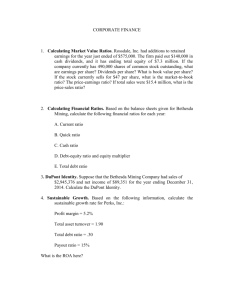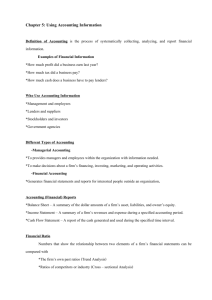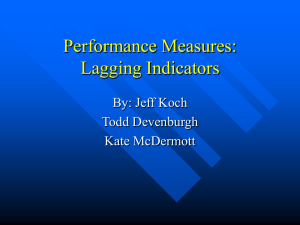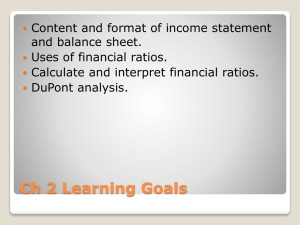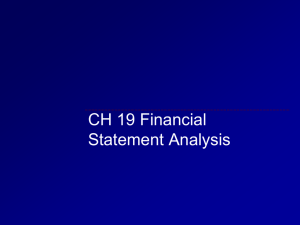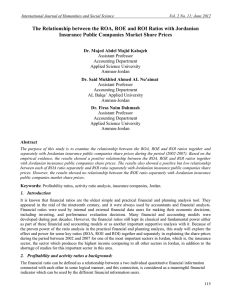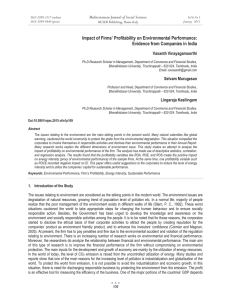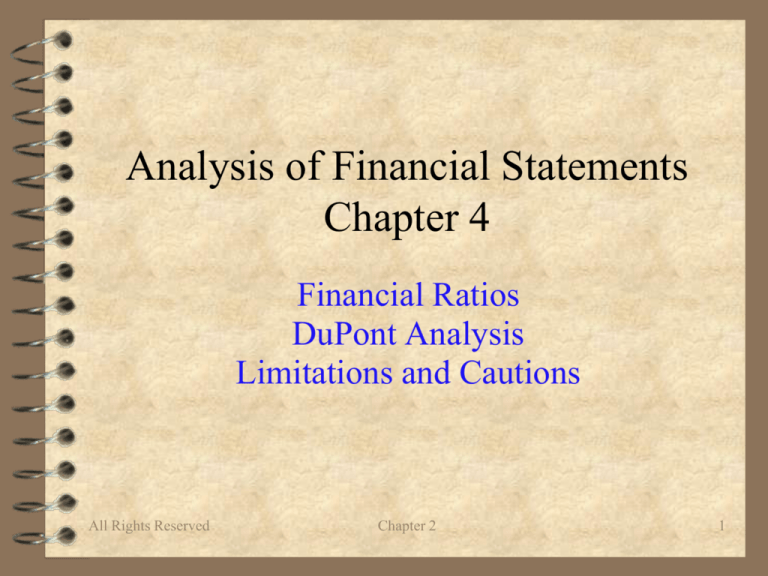
Analysis of Financial Statements
Chapter 4
Financial Ratios
DuPont Analysis
Limitations and Cautions
All Rights Reserved
Chapter 2
1
Financial Analysis Overview
A. Managers and Investors are continuously
analyzing company performance:
1.
2.
Managers: compensation is driven by performance in
areas of profitability and asset management.
Investors: wealth is affected by company
performance.
B. Managers are primarily interested in 4 areas:
1.
2.
3.
4.
Liquidity Management
Asset Management
Debt Management
Profitability Management
All Rights Reserved
Chapter 2
Page 2
More on Financial Analysis
A. Comparing [current to past] performance
1. Where have we improved?
2. Where do we need to improve?
3. How do we compare to the best run
companies in our industry? [benchmarking]
B. Key Problem Areas
1. Cost Management - key to profitability
2. Asset Management – “right-sizing”
All Rights Reserved
Chapter 2
Page 3
More on Financial Analysis
C. Why is Benchmarking Important?
1. Key to planning and strategy formulation.
2. Setting performance standards and goals for
improvement.
3. Lets the personnel people know where they
have to go to recruit top performers.
All Rights Reserved
Chapter 2
Page 4
Liquidity Management
A. Liquidity ratios measure the company's
ability to pay their bills: Accounts
Payable, Notes Payable, Accrued Expense
1. Current Ratio: $ in current assets per dollar of
current liabilities.
2. Quick Ratio: $ in quick assets per dollar of
current liabilities. (Inventory - low liquidity)
B. Desirable trends: depends on working
capital strategy and market volatility.
All Rights Reserved
Chapter 2
Page 5
Asset Management
A. Asset utilization ratios measure the
efficiency of asset management.
1. Inventory Turnover: increasing is good
2. Days Sales Outstanding: decreasing is good
3. Fixed Assets Turnover: increasing is good
4. Total Assets Turnover: increasing is good
All Rights Reserved
Chapter 2
Page 6
Debt Management
A. The extent to which assets and operating
expenses are financed by borrowing money.
1.
2.
Debt Ratio: stable over time, decreasing is good
Times Interest Earned: increasing is good
3.
Fixed Charge Coverage: increasing good
B. Many financial theorists favor borrowing
1. Method for increasing return on equity
2. Less expensive than equity
All Rights Reserved
Chapter 2
Page 7
Profitability Management
A. Profits result when a firm’s expenses are less
than its revenues.
B. Profitability is a proxy measure for the firm’s
ability to control costs.
1.
2.
3.
4.
5.
Gross Profit Margin (GPM) – direct costs
Operating Profit Margin (OPM) – all operating costs
Net Profit Margin (NPM) – how much to bottom line
Return on Total Assets (ROA) – overall return
Return on Common Equity (ROE) – stockholders
All Rights Reserved
Chapter 2
Page 8
Market Value Ratios
A. Investors are continually appraising
corporate performance. The Price /
Earnings ratio is a very good proxy for
how favorably or unfavorably investors
judge performance.
1. High growth, high profitability - HIGH P/E
2. low growth, poor profitability - LOW P/E
B. Other Measures or Ratios
1. Book Value per Share
2. Market to Book Ratio
All Rights Reserved
Chapter 2
Page 9
Trend Analysis
A. Trend analysis answers two very
important questions:
1. How has the company done over the last x
years in a particular area.
2. How does the company’s trend compare to the
industry average? Industry benchmark?
All Rights Reserved
Chapter 2
Page 10
Trend Analysis Example
Abbot Laboratories
Fiscal Years 1971 - 1990
COGS, SGA, NI as percent of Sales
0.6
Percent
0.5
0.4
0.3
0.2
0.1
0
Dec71 Dec73 Dec75 Dec77 Dec79 Dec81 Dec83 Dec85 Dec87 Dec89
Dec72 Dec74 Dec76 Dec78 Dec80 Dec82 Dec84 Dec86 Dec88 Dec90
Fiscal Year Ending
COGS Cost Rate
SGA Expense Rate
All Rights Reserved
Chapter 2
Net Profit Margin
Page 11
Trend Analysis
ABBOTT LABORATORIES
Cash Conv. Cycle vs. Defensive Interval
250
0.18
0.16
0.14
0.12
150
0.1
Percent
Number of Days
200
0.08
100
0.06
50
0.04
Dec71
Dec73
Dec75
Dec77
Dec79
Dec81
Dec83
Dec85
Dec87
Dec89
Dec72
Dec74
Dec76
Dec78
Dec80
Dec82
Dec84
Dec86
Dec88
Dec90
Fiscal Year End
Cash Conversion Cycle
All Rights Reserved
Defensive Interval
Chapter 2
Net Profit Margin
Page 12
DuPont System of Financial Analysis
A. DuPont System: a set of interrelated
financial ratios used to measure operating
performance.
1. ROE = ROA x (Total Assets/ Common
Equity)
a. ROA = NPM * TATO
b. EQTY MULT = TOTAL ASSETS / COM EQTY
c. TATO = Net Sales / Total Assets
4. ROE = NPM * TATO * EQTY. MULT.
All Rights Reserved
Chapter 2
Page 13
DuPont System
Net Inc =
N.P.M. =
Net Sales
COGS
SGA
INTEXP
TAXES
ROA =
Net Sales
T.A.T.O. =
Total Assets
ROE =
Times
Total Debt =
Current Liab
+
L-T Debt =
A/P
N/P
Accrual
Bonds
1-DR =
Total Assets
=
Current Assets
+
Fixed Assets
All Rights Reserved
Chapter 2
Page 14
Limitations of Ratio
1
Analysis
A. Industry averages affected by the presence
of heterogeneity between firms in a given
SIC.
1. Multiple lines of business in different market
sectors, domestic & international.
B. Inflation Effects;
1. Mostly on balance sheet and income
statement amounts.
2. Ratios are largely unaffected by inflation.
All Rights Reserved
Chapter 2
Page 15
Limitations of Ratio
2
Analysis
C. Accounting numbers always subject to
window dressing.
1. Although all US firms subject to GAAP,
practices vary from firm to firm.
D. Ratio magnitudes not absolute; a good
ratio in one environment can be bad in
another.
E. Firms can have a mix of good and bad
ratios making an overall rating difficult.
All Rights Reserved
Chapter 2
Page 16
Homework Assignment
A. Self-Test: ST-2
B. Questions: 4-2, 4-6, 4-10, 4-11 (parts a,
b, f, h, m, q)
C. Problems: 4-1, 4-6, 4-18, 4-21
All Rights Reserved
Chapter 2
Page 17

